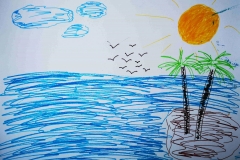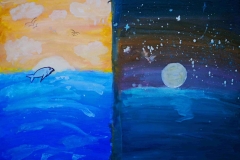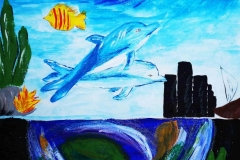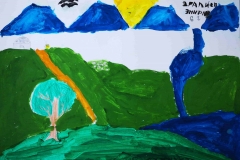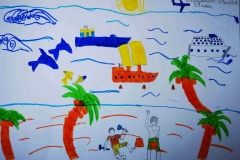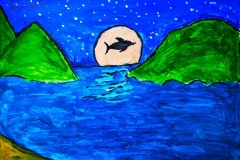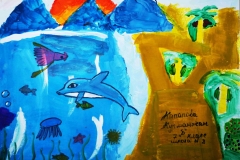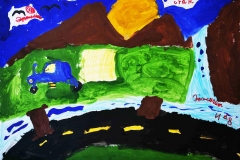Shamaldy-Sai settlement by the Naryn River (KYRGYZSTAN)
Most cities in the world developed along rivers, since these play an important role in urban life. Water is a vital substance not only in the ecological sense, but also in the social sense. This is especially evident in people’s interactions with rivers, which are the most populated water bodies in the world. When people interact with water, it ceases to be simply a molecule of H2O and takes on other social elements. This page will give you some insights into the life of the Shamaldy-Sai settlement on the Naryn River. The social anthropologist and exhibition coordinator Gulzat Baialieva herself was born and grew up in what is simply known as “poselok Shamaldy-Sai”.
This section touches on the themes of the Soviet discourse on modernizing “deserted”, “empty” places, the “taming” of nature (the documentary film “Are you worried, Naryn?”), the state of water infrastructure and the emergence of borders in Shamaldy-Sai. In addition, in the “Human” section you can see the art installation “Flows”,showing the constant cycle of migrating people and resources..
Administratively, Shamaldy-Sai is subordinated to Tash-Kumyr city. Shamaldy-Sai lies in Kyrgyzstan, 110 km from the province’s capital of Jalal-Abad and 34 km from the city of Tash-Kumyr.
“At the crossing of seven roads”
Shamaldy-Sai is a town of builders, who constructed several hydroelectric power plants (HPP). The very first on the Naryn River was Uch-Kurgan, then came Toktogul, Kurp-Sai, Tash-Kumyr and the Shamaldy-Sai HPP. As the eldest, Uch-Kurgan damis called the first-born of the Naryn hydropower cascade. Under construction in the 1960’s it was called the “most powerful” (180 MW), though now it is considered one of the minor hydroelectric power stations in the country.

After the collapse of the Soviet Union, despite the closure of local factories and the decline of industry in the 1990s, the settlement found a way to develop. Thus Shamaldy-Sai, established in 1956 as a temporary settlement to house dam-workers, continues to expand. Once designed for only 3,000 people, Shamaldy-Sai now serves over 18,000.
The success of the former industrial town as the locals themselves call it can be put down to its location – “at the crossings of seven roads”. Thus, connecting several regions and located at the border the town has profited as a trade hub.
“There was nothing but wind in Shamaldy-Sai”
In Kyrgyz “Shamaldy-Sai” means “windy valley”. Old residents recount that the force of the wind could lift a horse and rider up in this valley. Strong winds even now can tear electrical wires and trees, which is unusual in this area. Echoing a Soviet discourse on bringing life and modernization to a no man’s land, residents are convinced that there was nothing but wind in Shamaldy-Sai. Many emphasize that it was “deserted,” there were “no traces of humans” before the construction of the dam. Life here, they say, appeared only after the start of the Soviet electrification project. But was this really the case?


Yes, the development of urban life began in connection with the construction of the dam in 1956. But before that, there had to be something besides “wind”. Let’s look at the “emptiness” and absent “traces of man”: along the fields at the entrance to the settlement, there are overgrown rails. Once in a while, a goods train with carriages carrying coal or iron passes over them.
The abandoned railway station of “Shamaldy-Sai” was also built on the Tash-Kumyr – Uch-Kurgan railway line in 1936. There are also barracks from that period which have partially survived and are still in use. So there were “traces of man” before the construction of the hydropower plant. Besides, there are oral histories of the Jediger tribe and local battles in the 18th and 19th century.

Builders of the settlement, 1960 (Baialieva’s grandfather, family album)
According to the oral history of local hero Bazyl Baatyr, there was a ford on the Naryn River in the valley at Shamaldy-Sai. People stopped here with livestock, and made their camp for the night. The tribes of the left bank, in particular the Zhediger, crossed the river in Shamaldy-Sai to reach the Uzbek bazaars. The inhabitants of the right bank – the Saruu tribes and natives of Talas – crossed the Naryn River here to participate in Jediger celebrations and gatherings.
Water
As in many Central Asian regions there is an acute problem with access to drinking water Shamaldy-Sai and its surroundings. In most cases the problem lies with the infrastructure and organization of water supply. Residents of the settlement are used to regular failures and disconnections of piped water. For many years once a week on Wednesdays the water has been turned off. This is explained with the regular “cleaning of water works” schemes. The water system indeed requires major repairs. The water supply network was installed in 1957 and only in the central sections of Shamaldy-Sai village: today it has deteriorated almost completely. Today, unfiltered drinking water comes directly from the Naryn river.

The residents have different views on the water quality. Many do not know whether the water is purified. Since many neighbouring villages are not provided with water, they are forced to supply their households by fetching it in flaggons or buckets directly from the Naryn river. In the 90’s in Tendik village they used rods to transport water, now donkeys or even cars are used. For household water use, wells are drilled in the courtyards, and hauzes (small reservoirs) are dug.
Borders
Shamaldy-Sai used to be closely connected to the Uzbek city of Uch-Kurgan. Road communications with Uzbekistan ran first, along the railroad tracks from the branch station Shamaldy-Sai-Uch-Kurgan; second, along the highway (through the location called “Hlop punkt” – a Cotton Reception Center ) and third, over the bridge across the Naryn in the village of Kyzyl-Zhar. The administration and logistics of dam construction were in fact located in Uch-Kurgan in the 1960s. The famous Uch-Kurgan bazaar was another important point of connection between people on both sides of the borderSeemingly eternal ties, familial relations and fraternal feelings were affected when the border became much more rigid after the collapse of the Soviet Union. With independence gradually came border work on the demarcation of territories and border controls. International training assistance and funding the military and border guards. Unlike the southern part of the Ferghana Valley, which has many undescribed territories and conflict zones, there are no disputed territories in Shamaldy-Sai. However In 2000, due to religious extremism and the so-called “Batken events,” the Uzbekistani government ripped up the road to Uch-Kurgan, erected a border and blocked the road.

The Naryn bridge was dismantled and Shamaldy-Sai completely disconnected from Uzbekistan. Inter-ethnic cross-border families endured difficult years of separation. They had to make difficult decisions about whether to stay or migrate to reunite with their relatives. In 2003, it was decided to station the headquarters of the Jalal-Abad province border service in Shamaldy-Sai.

Thus, the abandoned former vocational school №108 became housing for the border guards, and the Soviet public transport depot (avtobaza) became the headquarters of the military forces. The hydroelectric power plants as well as these sites are now specially guarded areas. Today, the once unexpected appearance of the military and border guards in transboundary Shamaldy-Sai has become a routine and self-evident phenomenon.
IN THE FLOW
Gulzat Baialieva, Dinara Kanybek kyzy, Oksana Kapishnikova, Aidar Zhumabaev, Deniz Nazarova
Installation, collage
“In the flow” is a cyclic structure, illustrating the various flows circulating between Shamaldy-Sai and Moscow. These two distant places were once linked by ambitious projects of modernization.

The settlement of Shamaldy-Sai was established in 1956 as part of the construction of the Uch-Kurgan Hydroelectric Power Station – the “firstborn” on the Naryn River. Since 1914 this area has attracted hydrologists and engineers. From 1956 Moscow in particular regulated the first flow of labourers who were directed to build the town, plants and Uch-Kurgan hydroelectric station.

The next flow was the so-called “moskovskoe obespechenie” (Moscow provision) – supply of scarce and imported goods. The 1970s were the town’s golden era. With the collapse of the Soviet system, the local economy was disrupted. The factories, the flagships of the glorious past, were closed down.
Local inhabitants tried different ways of adapting to the economic crisis: market trade, agriculture and labor migration, mainly to Moscow. Moscow continues to be present in the new order. A flow of migrant workers send their earnings home to Shamaldy-Sai from Moscow.

Periodicals:National Library of the Kyrgyz Republic: Soviet Kyrgyzstan, April 1, 1962 #78 (10158); Soviet Kyrgyzstan, November 1, 1962 #259 (10339); “Lenin Jolu”, 09.01.1962
Contemporary photos: Author’s pictures, photos from the author’s online platform on the website “Odnoklassniki” – “NarynGES – Shamaldy-Sai”; photos of the active user of ABVG ABVG from the site “Odnoklassniki” – “NarynGES – Shamaldy-Sai”

Other Living Beings
There are scorpions, snakes and lizards in the dry and hot semi-arid zone of Shamaldy-Sai. Old residents remember how they hunted for large varans, which in recent years disappeared and were placed on the list of highly endangered species
There are a lot of mosquitoes and in the summer the locals use a net – “pashakana” around the trestle beds to ward off mosquitoes.

Fishing in Shamaldy-Sai is more of a hobby than a livelihood. Men fish at the “Nachalka/Nachalo” – the beginning of the canal that comes out of the Naryn and flows through Shamaldy-Sai. As a rule, only men and youths go fishing, making it a highly gendered leisure activity.
How do Children Imagine the Underwater World?
Who lives in the waters of the Naryn river?
We held an online drawing workshop for the children of Shamaldy-Sai. Pupils from local schools could fantasize about the underwater world. They were guided by an artist Cholpon Alamanova and organized by the local administration and school teachers. The pupils from 1st to 11th grade were free to take part in the event. Interestingly there are dolphins, whales, crabs, and other oceanic creatures drawn by young participants. The narrow and cold river doesn’t have any of these. Children’s drawings can be seen here.

